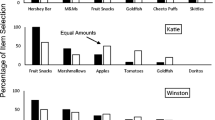Abstract
Matching theory is a mathematical theory of choice behavior, parts of which have been shown to hold in natural human environments and to have important therapeutic applications. Two modern developments in matching theory are discussed in this article. The first is the mathematical description of behavior in asymmetrical choice situations, which are situations where different reinforcers and/or different behaviors are associated with concurrently available response alternatives. Most choice situations in natural human environments are probably asymmetrical. The second development in matching theory is the mathematical description of a tendency toward indifferent responding in all choice situations. Behavior in asymmetrical choice situations and the tendency toward indifferent responding in all choice situations can be described by modifications of the matching equations, which change the equations from lines into power functions. These modern forms have been extraordinarily successful in describing behavior in choice situations, and are the forms most likely to accurately describe human behavior in naturally occurring environments.
Similar content being viewed by others
References
Baum, W. M. (1974). On two types of deviation from the matching law: Bias and undermatching. Journal of the Experimental A nalysis of Behavior, 22, 231–242.
Baum, W. M. (1979). Matching, undermatching, and overmatching in studies of choice. Journal of the Experimental Analysis of Behavior, 32, 269–281.
Baum, W. M. (1983). Matching, statistics, and common sense. Journal of the Experimental Analysis of Behavior, 39, 499–501.
Baum, W. M., & Rachlin, H. C. (1969). Choice as time allocation. Journal of the Experimental Analysis of Behavior, 12, 861–874.
Cliffe, M. J., & Parry, S. J. (1980). Matching to reinforcer value: Human concurrent variable-interval performance. Quarterly Journal of Experimental Psychology, 32, 557–570.
de Villiers, P. A. (1977). Choice in concurrent schedules and a quantitative formulation of the law of effect. In W. K. Honig & J. E. R. Staddon (Eds.), Handbook of operant behavior (pp. 233–287). Englewood Cliffs, NJ: Prentice-Hall.
Epling, W. F., & Pierce, W. D. (1983). Applied behavior analysis: New directions from the laboratory. The Behavior Analyst, 6, 27–37.
Herrnstein, R. J. (1961). Relative and absolute strength of response as a function of frequency of reinforcement. Journal of the Experimental Analysis of Behavior, 4, 267–272.
Herrnstein, R. J. (1970). On the law of effect. Journal of the Experimental A nalysis of Behavior, 13, 243–266.
Killeen, P. R. (1982). Incentive theory. In D. J. Bernstein (Ed.), Nebraska symposium on motivation 1981: Vol. 29. Response structure and organization. Lincoln: University of Nebraska Press.
Martens, B. K., & Houk, J. L. (1989). The application of Herrnstein’s law of effect to disruptive and on-task behavior of a retarded adolescent girl. Journal of the Experimental Analysis of Behavior, 51, 17–27.
McDowell, J. J (1981). On the validity and utility of Herrnstein’s hyperbola in applied behavior analysis. In C. M. Bradshaw, E. Szabadi, & C. F. Lowe (Eds.), Quantification of steady-state operant behaviour (pp. 311–324). Amsterdam: Elsevier/North-Holland.
McDowell, J. J (1982). The importance of Herrnstein’s mathematical statement of the law of effect for behavior therapy. American Psychologist, 37, 771–779.
McDowell, J. J (1986). On the falsifiability of matching theory. Journal of the Experimental Analysis of Behavior, 45, 63–74.
McDowell, J. J (1987). A mathematical theory of reinforcer value and its application to reinforcement delay in simple schedules. In M. L. Commons, J. E. Mazur, J. A. Nevin, & H. Rachlin (Eds.), Quantitative analyses of behavior: Vol. 5. The effect of delay and intervening events on reinforcement value (pp. 77–105). Hillsdale, NJ: Lawrence Erlbaum.
McDowell, J. J (1988). Matching theory in natural human environments. The Behavior Analyst, 11, 95–108.
McDowell, J. J, & Wixted, J. T. (1988). The linear system theory’s account of behavior maintained by variable-ratio schedules. Journal of the Experimental Analysis of Behavior, 49, 143–169.
McDowell, J. J, & Wood, H. M. (1984). Confirmation of linear system theory prediction: Changes in Herrnstein’s k as a function of changes in reinforcer magnitude. Journal of the Experimental Analysis of Behavior, 41, 183–192.
McDowell, J. J, & Wood, H. M. (1985). Confirmation of linear system theory prediction: Rate of change of Herrnstein’s k as a function of response-force requirement. Journal of the Experimental Analysis of Behavior, 43, 61–73.
Miller, H. L. (1976). Matching-based hedonic scaling in the pigeon. Journal of the Experimental Analysis of Behavior, 26, 335–347.
Mullins, E., Agunwamba, C. C., & Donohoe, A. J. (1982). On the analysis of studies of choice. Journal of the Experimental Analysis of Behavior, 37, 323–327.
Myers, D., & Myers, L. (1977). Undermatching: A reappraisal of performance on concurrent variable-interval schedules of reinforcement. Journal of the Experimental Analysis of Behavior, 27, 203–214.
Myerson, J., & Hale, S. (1984). Practical implications of the matching law. Journal of Applied Behavior Analysis, 17, 367–380.
Staddon, J. E. R. (1968). Spaced responding and choice: A preliminary analysis. Journal of the Experimental Analysis of Behavior, 11, 669–682.
Wearden, J. H., & Burgess, I. S. (1982). Matching since Baum (1979). Journal of the Experimental Analysis of Behavior, 38, 339–348.
Author information
Authors and Affiliations
Rights and permissions
About this article
Cite this article
McDowell, J.J. Two Modern Developments in Matching Theory. BEHAV ANALYST 12, 153–166 (1989). https://doi.org/10.1007/BF03392492
Published:
Issue Date:
DOI: https://doi.org/10.1007/BF03392492




